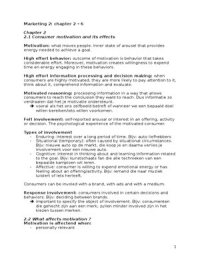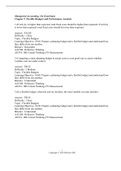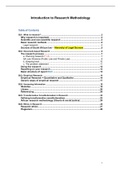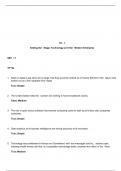Chapter 2
2.1 Consumer motivation and its effects
Motivation: what moves people. Inner state of arousel that provides
energy needed to achieve a goal.
High effort behavior: outcome of motivation is behavior that takes
considerable effort. Moreover, motivation creates willingness to expend
time en energy engaging in these behaviors.
High effort information processing and decision making: when
consumers are highly motivated, they are more likely to pay attention to it,
think about it, comprehend information and evaluate.
Motivated reasoning: processing information in a way that allows
consumers to reach the conclusion they want to reach. Dus informatie zo
verdraaien dat het je motivatie ondersteunt.
vooral als het ons zelfbeeld betreft of wanneer we een bepaald doel
willen bereiken/iets willen voorkomen.
Felt involvement: self-reported arousal or interest in an offering, activity
or decision. The psychological experience of the motivated consumer.
Types of involvement
- Enduring: interest over a long period of time. Bijv: auto liefhebbers
- Situational (temporary): often caused by situational circumstances.
Bijv: nieuwe auto op de markt, die koop je en daarna verlies je
involvement voor een nieuwe auto.
- Cognitive: interest in thinking about and learning information related
to the goal. Bijv: kunstschaats fan die alle technieken van een
bepaalde kampioen wil leren.
- Affective: consumer is willing to expend emotional energy or has
feeling about an offering/activity. Bijv: iemand die naar muziek
luistert of iets herleeft.
Consumers can be involed with a brand, with ads and with a medium.
Response involvement: consumers involved in certain decisions and
behaviors. Bijv: deciding between brands.
important to specify the object of involvement. Bijv: consumenten
die gehecht zijn aan een merk, zullen minder involved zijn in het
kiezen tussen merken.
2.2 What affects motivation ?
Motivation is affectend when:
- personally relevant
1
, - consistent with your values, need, goals, emotions and self-control
processes
- risky
- moderatly incosistent with their prior attitudes
Personal relevance: the extend to which it has a direct bearing on and
implications for your life
relevance fuels your motivation
Self-concept: hoe je jezelf ziet en hoe je denkt dat andere je zien. It
frequently motivates our behavior.
Values: abstract beliefs that guice what people regard as important or
good.
Needs: internal state of tension caused by disequilibrium from an ideal or
desired state. Needs kunnen ons naar een product/service toe leiden,
maar ook juist er vandaan. Bijv: je durft niet naar de tandarts.
Maslow piramide
1) physiological: food, water and sleep
2) safety: shelter, protection, security
3) social: affection, friendship, to belong
4) egoistic: prestige, success, accomplishment, self-esteem
5) self-actualization: self-fulfillment en enriching experiences
ignores the intensity of needs and the resulting affect on motivation
ordering may not be consistent across cultures
Types of needs
Social Non-social: not based
on other people
Modeling Functional: need that Safety
Support motivates the search Order
for offerings that solve Physical well-being
consumption-related
problems
Status Symbolic: hoe we Self-control
Affiliation onszelf zien, hoe Independence
Belonging anderen ons zien, hoe
Achievement we ons relateren aan
anderen and the
esteem in which we
are held by others.
Reinforcement Hedonic: need that Sensory stimulation
(binding) relates to sensory Cognitive stimulation
Sex pleasure Novelty (nieuwe
Play dingen)
2
, Characteristics of needs
- needs are dynamic: satisfaction is only temporary. Bijv: iets eten stilt
je honger niet voor altijd
- needs exist in a hierarchy: some needs assume more importance
than others
- can be internally or externally aroused: bijv: pizza ruiken kan ervoor
zorgen dat je iets wilt eten
- needs can conflict:
* approach-avoidance conflict: inner struggle om iets te kopen
als het een behoefte wel bevredigt, maar een andere behoefte juist
niet. Bijv: roken.
* approach-approach conflict: inner struggle about which offering
to acquire when each van satisfy an important but different need.
Bijv: voor twee dingen uitgenodigd worden op dezelfde avond
* avoidance-avoidance conflict: inner struggle about which
offering to acquire when neither can satisfy an important but
different need. Bijv: alleen naar huis fietsen of nog een uur wachten.
Goal: outcome that we would like to achieve. More specific and concrete
than needs.
Goal setting and pursuit: consumer behavior is a continuous cycle of
setting goals, pursuing them, determining success and failure of goal
pursuit, and adapting the goals.
Goals and effort: the more we can visualize our goals, the more
motivated and commited we are to putting in effort towards the goals.
when people are close to attaining one of their goals, people tend to
reduce effort on pursuing that goal and redirect it to other goals.
Types of goals
- concrete: specific to a given behavior/action and determined by the
situation at hand. Bijv: op tijd komen
- abstract: over a longer period of time. Bijv: being a good student
- promotion-focused: to achieve positive outcomes
- prevention-focused: to avoid negative outcomes (safety etc against
risks)
Goals and emotions
Appraisal theory: our emotions are determined by how we think about a
situation or outcome. Positive emotions when an outcome is consistent
with our goals and vice versa.
Self-control: to regulate feelings, thoughts and behavior in line with long-
term goals.
Ego depletion: the idea that people get tired of making decisions
because it is process that requires energy. Leads to reducing decision
quality.
3







